
Our IHM Presence outreach effort is intended to be a point of light, a “bright spot” in your very busy lives connecting you in a more meaningful way with the charism and mission of the IHM Congregation. It will highlight our Alphonsian spirituality and provide helpful information on the many enrichment opportunities offered by the Congregation throughout the year. Enjoy!
January Presence Reflection
by S. John Evelyn DiTrolio
 January is marked by so much ‘newness’: new beginnings, new goals, new resolutions and for some, perhaps a new home or new ministry. Spiritually, I find January filled with opportunities to let go of anything in the past year that was hurtful, stretching or challenging in any way and to be open to new graces of life and opportunity.
January is marked by so much ‘newness’: new beginnings, new goals, new resolutions and for some, perhaps a new home or new ministry. Spiritually, I find January filled with opportunities to let go of anything in the past year that was hurtful, stretching or challenging in any way and to be open to new graces of life and opportunity.
In order to do this, we can rely on the inspiration of saints who led lives of virtue! During the Christmas season an IHM custom is to choose a “Court of the King”. St. Alphonsus, our patron, had a great devotion to the Incarnation. The Courts of the King include a person or thing that was present at the crib on Christmas night. There is a corresponding virtue or practice that goes with each Court. For example, if I choose Mary, my practice is to live the gift of faith trusting in the power of the Holy Spirit. If I choose the Angels, my practice is to proclaim the Good News to all people. Our IHM schools have the students pick a Court of the King before they go home for Christmas break. Hopefully they will remember their ‘practice’ throughout the New Year.
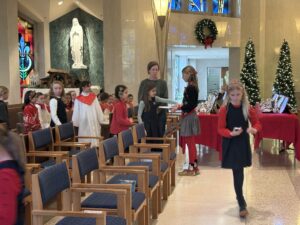 IHMs have another custom of choosing a Virtue, Patron and Intention on New Year’s Day. This is another source of spiritual strength and guidance as we enter a New Year of grace.
IHMs have another custom of choosing a Virtue, Patron and Intention on New Year’s Day. This is another source of spiritual strength and guidance as we enter a New Year of grace.
Perhaps you would like to think of a saintly Patron who could inspire you through the year or resolve to practice a virtue that will bring you closer to God and to His people!
May our God of new beginnings open our hearts to receive every grace He has in store for us as we enter 2026!
God bless you!
*Courts of the Infant King (Adult Version)
*Courts of the Infant King (Child Version)
*Courts of the Infant King Vespers (Evening Prayer)
December Presence Reflection
by Sister Marie Gipprich
The IHM Mission Statement Video…Enjoy!
The purpose of a religious congregation’s Mission Statement is the declaration of the congregation’s core purpose and their values. It explains why the congregation exists, providing a clear direction for the members while fostering unity and a shared purpose.
Our Mission Statement begins by noting the importance of our charism of love, creative hope, and fidelity—special graces bestowed on the congregation through the spirit of our founders. One of our founders, Father Louis Florent Gillet, a Redemptorist priest, instilled in our early sisters the spirit of and a devotion to Jesus, the Redeemer.
Our vowed consecration allows the sisters to focus on God and our mission rather than our own self will. Our daily life of prayer is a direct channel with God, fostering a deeper relationship with God. The celebration of Eucharist is at the center of our lives. It unites us with Christ and others, giving us spiritual nourishment and strength.
The Sisters of IHM consider community living an opportunity for spiritual growth through shared worship, ministries, and the common life. It affords each member the ability to practice forgiveness, love and unity.
In all of our ministries, joyful service is the foundation that strengthens our relationships with those we serve and with each other, giving witness to faith.
Our Mission Statement ends with a rather bold statement of our “bottom line”: to engage God’s people through evangelization in all our varied ministries.
This IHM Mission Statement not only tells the world who we are but also ensures each one of us as members of the congregation that a response to God‘s call must ensure God‘s purposes. In the example of Jesus, the Redeemer, we try to live the message of God’s love and freedom for all, especially the poor and the abandoned.
November Presence Reflection
by S. Rita Murphy
A Story of God’s Provident Love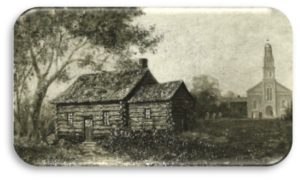
Each year on November 10th, the IHM’s celebrate FOUNDERS’ DAY! What a special time to recall and marvel once again in the story of how Divine Providence inspired and shaped the foundation of the IHM community – especially the founders’ lives! It all began in 1845 in a log cabin in Monroe, Michigan. Father Louis Florent Gillet was a young Redemptorist missionary priest working with poor French-speaking immigrants on the Michigan frontier. After searching in vain for a group of religious to help him provide a faith-based school for his parishioners, Father Gillet decided he would found a religious community of sisters. Divine Providence intervened when Sister Mary Theresa Maxis, who had belonged to the Oblate Sisters of Providence and had met Father Gillet during his visit to Baltimore in 1843, answered a call within a call, which led her to join Father Gillet in Michigan.
In the biography of Father Gillet, entitled I Desire to Be Everywhere, and written by Fr. Gilbert Enderle, C.Ss.R, one can clearly see Divine Providence guiding both Theresa Maxis and Father Gillet through some very tumultuous and trying times. Mother Theresa Maxis’ journey from Baltimore to Monroe to Pennsylvania to the Grey Nuns in Ottawa and back to the IHM’s in West Chester, Pennsylvania, is a well-known story and a testimony to the power of Divine Providence. Not so well known is the fact that Fr. Gillet had a similar experience of misunderstanding, separation, rejection and being guided by Divine Providence over the years.
In 1847, just two years after the IHM foundation in Monroe, John Neumann, then Vicar-General for the Redemptorists, assigned Father Gillet to a Redemptorist mission in New York, and from there he was subsequently reassigned over the next 8 years to missions in Illinois, Louisiana, Missouri, Ohio, and Indiana. In 1855, Fr. Gillet returned to his native Belgium never knowing what had happened to the congregation of sisters he helped found in Monroe, MI. After leaving the Redemptorists in 1856, Father Gillet served in parishes in northern France until entering the Cisterians in Hautecombe, France.
Divine Providence intervened once more in 1891, when Father Gillet, through correspondence with Sister Clotilde in Pennsylvania, learned that the women religious he had founded in Michigan had flourished and had changed their name from the Sisters of Providence to the Sisters, Servants of the Immaculate Heart of Mary. Since we know it is through Divine Providence that God accomplishes His will, this rediscovery and reunion illustrate that God’s purposes were surely fulfilled in the lives of Father Gillet and Mother Theresa. As we sing our “Praise, Love, Thanksgiving” in celebration of this graced history, let us rejoice and remain confident in the power of God’s continuing Provident Love to lead us into the future!
when Father Gillet, through correspondence with Sister Clotilde in Pennsylvania, learned that the women religious he had founded in Michigan had flourished and had changed their name from the Sisters of Providence to the Sisters, Servants of the Immaculate Heart of Mary. Since we know it is through Divine Providence that God accomplishes His will, this rediscovery and reunion illustrate that God’s purposes were surely fulfilled in the lives of Father Gillet and Mother Theresa. As we sing our “Praise, Love, Thanksgiving” in celebration of this graced history, let us rejoice and remain confident in the power of God’s continuing Provident Love to lead us into the future!
October Presence Reflection
by S. Anne McGuire
The Beauty, the Power, and the Promise of the Rosary
 The fourth glorious mystery of the rosary invites us to meditate on the blessed Mother’s Assumption into heaven at the end of her earthy life.
The fourth glorious mystery of the rosary invites us to meditate on the blessed Mother’s Assumption into heaven at the end of her earthy life.
August 15th, the celebration of Mary being taken body and soul into heaven is a Marian dogma of the Catholic Church celebrated since the fourth century; dogmatized in1950.
By her Immaculate Conception and her faith filled ”yes”, Mary is the first and unparalleled disciple of Jesus. She lived her life in complete union with the holy will of God neither questioning nor fearing. She deeply loved and remains passionately concerned for the welfare of her children throughout the ages.
Mary is the new Eve as well as the new Arc of the Covenant of salvation, because Mary, in her humble obedience, carried Jesus within her womb.
The gospel that is read on the feast of the Assumption, Luke 1:39-56, narrates the story of the young Mary journeying in hast to her elderly cousin, Elizabeth. Overjoyed, Mary’s enrapture crescendoed in the prayerful song, “The Magnificat”. She proclaims that her soul glorifies the Lord, that great things have been done to her and the Almighty remembers His mercy in every generation.
This solemnity is not Mary being taken from us but rather her connectedness to us and her identity with the human condition. She accompanies us as we struggle to become who God calls to be, human to our full potential. The Blessed Mother hears our prayers, sees our needs and is compassionate with our struggles, pains, failures, disappointments, loneliness and confusions.
On this feast day we could ask for our own Assumption of heart and mind; to be more in tune with those whose situation is heartbreaking and/or unjust.
Can we feel with our brothers and sisters who are marginalized because of race, creed, color of their skin or place of origin?
Will we say a prayer for people in countries that are ravaged by war? Shouldn’t we reach out to the homeless who were forced to flee their homeland only to be rejected by another?
We must identify with these children of Mary, our brothers and sisters.
As this glorious feast approaches, l suggest that we lift our prayer to Mary asking her to increase our capacity to love and care beyond our limited periphery.
If you are someone who dips your feet into the ocean on the 15th of August, include a prayer to Mary for those who cannot pray for themselves then reach out to someone you know who could use a lifting of their spirit.
You will be surprised how their joy raises you.
September Presence Reflection
by S. Mary Lydon
The IHM Congregation Seal (Immaculata, PA)
This month’s message comes from Camilla Hall, nursing home and retirement center for our sisters. How do we continue to live the messages of contemplation and action hidden in this seal?
August Presence Reflection
by S. Eileen Buchanan
THE FEAST OF T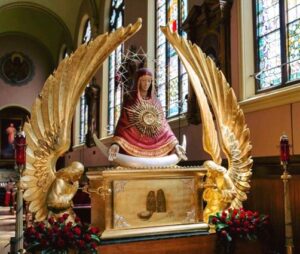 HE ASSUMPTION OF THE BLESSED VIRGIN MARY
HE ASSUMPTION OF THE BLESSED VIRGIN MARY
The fourth glorious mystery of the rosary invites us to meditate on the blessed Mother’s Assumption into heaven at the end of her earthy life.
August 15th, the celebration of Mary being taken body and soul into heaven is a Marian dogma of the Catholic Church celebrated since the fourth century; dogmatized in1950.
By her Immaculate Conception and her faith filled ”yes”, Mary is the first and unparalleled disciple of Jesus. She lived her life in complete union with the holy will of God neither questioning nor fearing. She deeply loved and remains passionately concerned for the welfare of her children throughout the ages.
Mary is the new Eve as well as the new Arc of the Covenant of salvation, because Mary, in her humble obedience, carried Jesus within her womb.
The gospel that is read on the feast of the Assumption, Luke 1:39-56, narrates the story of the young Mary journeying in hast to her elderly cousin, Elizabeth. Overjoyed, Mary’s enrapture crescendoed in the prayerful song, “The Magnificat”. She proclaims that her soul glorifies the Lord, that great things have been done to her and the Almighty remembers His mercy in every generation.
This solemnity is not Mary being taken from us but rather her connectedness to us and her identity with the human condition. She accompanies us as we struggle to become who God calls to be, human to our full potential. The Blessed Mother hears our prayers, sees our needs and is compassionate with our struggles, pains, failures, disappointments, loneliness and confusions.
On this feast day we could ask for our own Assumption of heart and mind; to be more in tune with those whose situation is heartbreaking and/or unjust.
Can we feel with our brothers and sisters who are marginalized because of race, creed, color of their skin or place of origin?
Will we say a prayer for people in countries that are ravaged by war? Shouldn’t we reach out to the homeless who were forced to flee their homeland only to be rejected by another?
We must identify with these children of Mary, our brothers and sisters.
As this glorious feast approaches, l suggest that we lift our prayer to Mary asking her to increase our capacity to love and care beyond our limited periphery.
If you are someone who dips your feet into the ocean on the 15th of August, include a prayer to Mary for those who cannot pray for themselves then reach out to someone you know who could use a lifting of their spirit.
You will be surprised how their joy raises you.
(Photo credit: “Our Lady of the Sign – Ark of Mercy”, by Artist Stefan Niedorezo, in St. Stanislaus Kostka Church)
July Presence Reflection
Understanding our Monthly Practices
by S. Monica Sicilia
Rooted in the teachings of St. Alphonsus Liguori, the Sisters, Servants of the Immaculate Heart of Mary (IHMs) focus on a monthly practice that emphasizes an apostle, a particular virtue and a scripture passage. This focus leads individuals to deepen their understanding of our call to live Gospel values, integrating them into our daily lives and enriching our personal and spiritual growth. This focused attention encourages mindfulness and helps to cultivate habits that might otherwise be overlooked in the hustle and bustle of everyday life.
Ultimately, this Alphonsian tradition serves as a powerful reminder of the importance of intention in our lives. By consciously choosing a particular focus each month, we not only enhance our own lives but also contribute positively to the world around us. The IHM Sisters, inspired by Saint Alphonsus, have taken this approach to heart. Their commitment to education, service, and spiritual formation embodies the call to cultivate virtues not just for personal benefit but for the sake of the community.
The month of July calls us to emulate the lives of Saint Thomas, known for his public profession of faith in Jesus’ divinity and Saint James the Less, known for his commitment to social justice and equity. While purity of heart is needed for deep connection with God, it also calls us forth to examine our inner motivations, our underlying intentions and desires behind them. A pure heart is driven by genuine love for others, seeing them as valuable individuals.

Foundations of Freedom
In reflecting on Saint Alphonsus Liguori and the virtue of freedom, we are called to consider the depth of our own freedom in relation to God and others. His teachings inspire us to seek a freedom that is grounded in love, guided by grace, and expressed in service to the community. As we strive to live out this understanding of freedom, we are reminded that it is in embracing the divine will and supporting one another in our journeys that we can truly experience the fullness of life that God intends for us. Saint Alphonsus Liguori’s legacy continues to challenge us to pursue a deeper, more authentic freedom that leads to holiness and wholeness. Authentic freedom is rooted in love—both for God and for others.
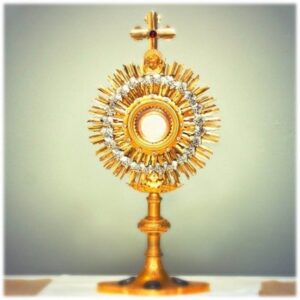 June Presence Reflection
June Presence Reflection
by S. Anne Marie Stegmaier
The Most Holy Body and Blood of Christ or Corpus Christi (this year on June 22) is liturgically the last Sunday before we move back into the Sundays of Ordinary Time – the weeks named by an ordinal number. On Corpus Christi when I was a child, I remember all the children in the First Holy communion class, dressed in their white finery, processing in front of the priest who carried the Eucharist in the monstrance in procession. Eucharistic Processions and adoration are still encouraged today and you may have been able to participate in one or more.
While I don’t know that as a child I truly understood the significance of Holy Communion or the Solemnity of the Body and Blood of Christ, I do know that the experiences created a memory. Today, I have grown in my belief, knowledge, and love of Our Lord in the Most Blessed Sacrament. The Alphonsian/Redemptorist tradition that we I.H.M.s follow, “contains an explicit notion of the imitation of Christ, analogous to our understanding of the Eucharist.” (Faithful Servant p. 18). Just as the bread and wine truly become the Body and Blood of Jesus, so are we transformed to really become Christ, the servant of all. We receive Jesus, Body and Blood, Soul and Divinity, in the Eucharist daily. We I.H.M.s reserve the Eucharist in all of our convent chapels so that we may visit often in intimate prayer. We recognize Jesus in the Eucharist as the “center and animating force” of our life. We accept the challenge to receive the nourishment of the Eucharist and with that spiritual energy carry out our mission and ministry of preaching the Gospel to all, especially the poor and most abandoned.
 St. Augustine said: “Believe what you see, see what you believe and become what you are: the Body of Christ.” When we say “Amen”, we are saying “Yes! I believe this is the Body and Blood of Christ and that I will be the Body of Christ to others.” As Genesis reminds us “God created mankind in his image; in the image of God he created them.” (Gen. 1:27) We are all created in this same divine image and grow in our understanding of this truth until we reach heaven. We are challenged to be the servant of all as Jesus showed us through his service of others in His life and through His death.
St. Augustine said: “Believe what you see, see what you believe and become what you are: the Body of Christ.” When we say “Amen”, we are saying “Yes! I believe this is the Body and Blood of Christ and that I will be the Body of Christ to others.” As Genesis reminds us “God created mankind in his image; in the image of God he created them.” (Gen. 1:27) We are all created in this same divine image and grow in our understanding of this truth until we reach heaven. We are challenged to be the servant of all as Jesus showed us through his service of others in His life and through His death.
May any emptiness you feel, any longing or yearning you experience, be filled by your reception of Jesus in the Holy Eucharist. And may we all continue to pray for an increase in priestly vocations to celebrate Mass, consecrating the bread and wine to become the Body and Blood of Christ. God bless you!
May Presence Reflection
Presence Reflection
The Solemnity of Pentecost
and Mary, Our Blessed Mother
by S. Monica Sicilia
The Solemnity of Pentecost is marked by selecting a gift of the Holy Spirit to focus on and cultivate throughout the year. This practice involves seeking opportunities to exercise that gift in service to God and others.
As Sisters, Servants of the Immaculate Heart of Mary (IHMs), we hold a deep and integral connection to the Holy Trinity. May, the month dedicated to Our Lady, and our identity as a Marian Congregation leads us to clearly identify our own spiritual connection with how our devotion to Mary and the Blessed Trinity intertwine:
Mary as a Pathway to the Trinity:
For IHM sisters, devotion to Mary is not an isolated practice. Rather, it serves as a pathway to a deeper relationship with the Holy Trinity. Mary, as the Mother of God, is seen as a perfect example of one who was wholly open to the will of God—Father, Son, and Holy Spirit.
Through Mary’s “yes” to God, she became instrumental in the Incarnation, bringing the Son into the world. Therefore, IHM sisters, by honoring Mary, are drawn closer to Jesus Christ, and consequently, to the entire Trinity.
Trinitarian Foundation:
Like all Catholic religious orders, the IHM sisters’ spirituality is grounded in the belief in the Triune God. Our lives of prayer, service, and community are rooted in this fundamental Christian doctrine. Our work, particularly in education and pastoral ministry, reflects the love of God that flows from the Trinity as we strive to bring that love to God’s people and the world.
IHM Charism and Mary’s Role:
The IHM charism emphasizes Mary’s role in the plan of salvation. By focusing on her Immaculate Heart, the sisters seek to emulate her virtues, such as humility and love. These virtues are essential for a deeper connection with the Trinity. It is important to remember that all devotion to Mary, in the catholic faith, is meant to draw the believer closer to her son Jesus Christ, and therefore to the whole of the Holy Trinity.
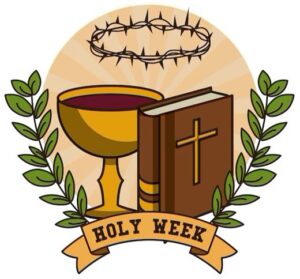 April Presence Reflection
April Presence Reflection
by S. Emily Vincent Rebalsky
There is a tradition of our faith, which I find so moving, that takes place on Holy Thursday evening after the Celebration of the Lord’s Supper. The faithful travel from church to church to visit the altars of repose. It was inspired from Jesus’ cry to His disciples when He found them asleep at the Garden of Gethsemane after He had asked them to keep watch for Him and pray, “. . . you could not keep watch with me for one hour?” Matthew 26:40. The faithful long to be true friends of Jesus by staying up and being with Him while they pray.
It is a beautiful way to show our friendship to others when we are there with them during hard times. This is why we want to spend that extra time with Jesus—even when we would rather sleep or rest, we sit and wait and pray. Good Friday is another opportunity to spend time honoring Jesus and taking in all He suffered for our sins as He died on the cross. People used to refrain from watching television or listening to the radio on Good Friday or at least between the hours of noon and three. As IHM Sisters, we have a quiet retreat day where we take extra time to pray, meditate on His passion, pray the Stations of the Cross, read Scripture, and attend church. Good Friday is the only day of the year when Mass is not celebrated. However, your parish will have the Liturgy of the Lord’s Passion, which includes veneration of the Holy Cross, and reception of Holy Communion which had been reserved from the Mass of the Lord’s Supper on Holy Thursday.
During Holy Week, in addition to taking the time to participate in your Church’s Triduum services, you might think of putting aside your favorite television show, game app, or social media scrolling and use technology instead to try a new prayer app or watch a movie about Jesus’s life.
Your celebration on Easter Sunday will be so much richer for having spent time with our Lord in His suffering. You will now truly rejoice in His Resurrection!
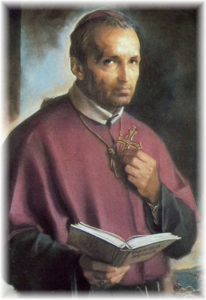 March Presence Reflection
March Presence Reflection
by S. Mary Sue Carwile
St. Alphonsus and the Cross
St. Alphonsus Liguori, a theologian who taught passionately about the redemptive power of Christ’s love, saw the Passion and Death of Jesus as an overwhelming expression of divine love for each of us. For him, the mystery of Redemption was not just a theological truth, but a personal invitation to experience God’s love in our own lives, especially in the midst of suffering and how this perspective can transform our understanding of suffering and hope.
St. Alphonsus teaches us that the Passion of Christ reveals the profound humility of God. Jesus, fully divine, emptied Himself of His Godliness to take on the fullness of humanity. This is an act of ultimate love—one that we cannot fully comprehend.
As I reflected on the mystery of the Cross and how St. Alphonsus has influenced my own spiritual life as an IHM, and how, having been taught by Sisters of IHM my entire life, the influence of the Cross began from my first days of school. Below I share a short personal reflection.
Prayer Before a Crucifix
Look down upon me, good and gentle Jesus,
while before Your cross I humbly kneel
and with burning soul, pray and ask You to fix deep in my heart
the virtues of faith, hope, and charity,
true sorrow for my sins, and a firm purpose of amendment.
While I gaze upon, with great love and tender pity,
Your five most precious wounds,
I call to mind the words of David, Your prophet,
“They have pierced My hands and My feet; they have numbered all My bones.”
Amen.
This prayer has significant meaning in my life. When I started school, on first Friday, we attended Mass as a school community. At the end of every Mass, we recited the Prayer before the Crucifix. I was fascinated and dismayed that everyone but me seemed to know this prayer. Each time we attended Mass, I hoped to learn a little more of it. As a child, I was deeply touched by the first two and final two lines. By first grade, I had them mastered. As I moved from grade to grade, the middle of the prayer eluded me over and over (this was long before the days of Google!). I was also a very shy child and so asked for no help in this endeavor. Finally, I was able to learn this prayer in its entirety and imprinted it on my heart. It is a daily prayer for me.
Moving forward in my life, I answered the call to become a member of the Sisters, Servants of the Immaculate Heart of Mary, whose spirituality is founded on the spirituality of St. Alphonsus Liguori. St. Alphonsus believed and taught that God is “crazy in love with us,” His creation. He explored the Incarnation, our Redemption, the Blessed Sacrament and his beloved Mother of God as the avenues through which we, through contemplation, would lead us to the practice of the love of Jesus Christ. Contemplation on the Cross, the Crucifixion, leads us deep into the awareness of God’s unending love for each of us and our neighbors.
God is crazy in love with us. As a small child, I had little understanding of the words I was trying to learn and pray, yet they touched my heart and somehow, I held them there. My understanding grew with age and my immersion into IHM Spirituality has deepened, not only my appreciation for the Sacrifice of Jesus on the Cross, but also the love with which He holds for each of us as life presents us with concerns, some small and some painful and life changing. As we enter the season of Lent on March 5, the Cross takes on an intimate significance in our spiritual life. It is not only a sign of our hope and redemption, but also an invitation to enter into the heart of God as we accept the infinite love he holds for each of us and our neighbors everywhere. We are His and we are held in His heart and arms.
February Presence Reflection
by S. Marie Gipprich, IHM
Patron Saints and Virtues
It is a common practice among Catholics to honor their patron saint, the particular saint whose name we were given at Baptism and/or Confirmation. Celebrating that saint is a way to give thanks for his or her intercession in our lives. It’s like having our own special “guardian.” Also, it is a reminder of the saint’s life and virtues that we should try to emulate.
Celebrating a saint’s virtues is to intentionally focus on developing a particular positive character trait of that saint in order to build our own strong moral character. The practice of virtues can help us take charge of our own growth in holiness.
Research studies indicate that virtues like kindness, forgiveness, love of God, purity, and mortification can actually protect us from the negative practices so prevalent in society today. One act of honesty doesn’t make a person honest, but continued determination to be honest by practicing honest acts makes you and me honest persons.
St. Alphonsus, one of the patron saints of the IHM Congregation, encouraged each sister to adopt the practice of listing the monthly saints and virtues, “matching the twelve apostles with the twelve months of the year.” Each month, a designated patron saint and virtue are paired with a corresponding scripture passage. Our Congregation continues this tradition today, striving to emulate the patron saint and embody their virtue throughout the month.
February Patron Saint and Virtue
During the month of February, we honor St. Peter as our patron saint along with the virtue of hope. The accompanying scripture is from Psalm 91:14 – Those who cling to me, I will deliver; I will set those on high, who acknowledge my name.
St. Peter the Apostle is a powerful example of walking in hope, even in moments of doubt and weakness. Though he faltered when walking on water and denied Jesus three times, he remained steadfast in his faith, ultimately becoming the rock upon which Christ built his Church. His journey reminds us that true hope is found in trusting God’s mercy and rising each time we fall.
When I reflect on the virtue of hope, I think back to many years ago, when I was studying Theology in Vermont. I met an amazing woman whose husband had been a popular and well-known radio personality in Chicago for many years. He had died recently, and she was struggling with the loss of his companionship. During one of our conversations, she asked what I thought hope was and how we should live in hope. Her question made me pause. After a moment or two, I remarked that hope, for me, was never giving up. It meant that no matter how discouraged, sad, angry, or confused I might be, I remember that what God has done for me in the past, God will do in the present and future. As long as I am still crying out to God for help, there is hope.
I find hope whenever I see people reaching out to others who are in need. I find hope when I recall a recent conversation with a friend that encouraged me. I find hope when I see in someone else a deep love for others. I find hope when, after a good cry, I feel God’s love and presence. I find hope when I hear about scientists and medical professionals working hard to cure diseases. I find hope when I see ordinary people doing their jobs which enrich or assist us. I find hope when I meet so many who desire a deeper relationship with God — and a desire to share that with others. I find hope in music, poetry, art, laughter, inspiration, dedication. And I find hope in every prayer that reaches the all-loving heart of God.
 Joan Chittister wrote, “Hope reminds us that there is nothing in life we have faced that we did not, through God’s gifts and graces — however unrecognized at the time — survive.” This is, indeed, hope.
Joan Chittister wrote, “Hope reminds us that there is nothing in life we have faced that we did not, through God’s gifts and graces — however unrecognized at the time — survive.” This is, indeed, hope.
On December 24, 2024, Pope Francis opened the Holy Door to begin a Jubilee year for 2025. It is the tradition of the Church to celebrate such a year every 25 years, to give every generation a chance to experience a special time of grace in their lifetime. “Jubilee,” the name given to a particular year, comes from the instrument used to mark its beginning. The instrument is called the yoble, the ram’s horn that was used to proclaim the Day of Atonement (Yom Kippur) for the Jewish people. In the bible, a Jubilee year was marked every 50 years to be marked as a time to re-establish a proper relationship with God, one another, and all creation. Pope Paul II ordained that a Jubilee year be celebrated every 25 years.
The theme for this Jubilee year is “Pilgrims of Hope.” The logo for the Jubilee year represents this theme, showing four stylized figures which represent all humankind coming from the four corners of the earth. They are shown as embracing one another in solidarity which should unite all people. The figure in the front holds the cross. It is a sign of faith and hope. The rough waves under the figures indicate that our life journey is not always calm but often requires a greater call for hope. The significant thing about this logo is the cross itself. It is elongated and turns into an anchor, the symbol of hope. The cross seems to be dynamic, stretching out to all people so that no one is left alone.
Pope Francis, in his letter concerning the Jubilee year, states “We must fan the flame of hope that has been given us and help everyone to gain new strength and certainty by looking to the future with an open spirit, a trusting heart and far-sighted vision.” In these very difficult and unsure times, these words touch the hearts of all of us. They speak of the desire within each one to be open to God’s plan, knowing that God will be with us always on this journey. We are pilgrim people, which means we travel together toward a destination. No one walks this path alone. It is in the journey that we become one!
To view a complete listing of the patron saints and virtues for each month, click here.
 January Presence Reflection
January Presence Reflection
By S. Jeannine Norton, IHM
As we enter a new year, it is somewhat like driving to an unfamiliar destination. You can’t just get in the car and go; you need directions! You can ask someone, check a map or online assist, or let WAZE direct every turn, but if you are going to arrive on the best path, you need guidance from a source “who’s been there, done that.”
As IHMs, we have a New Year’s Day devotion that provides a guide for the unknown days ahead of us. We want to travel in our Charism “vehicle” of love, creative hope and faithfulness but the route is not always clear and smooth. We need guidance from saintly sources who have traveled this road before.
Therefore, the sisters gather in chapel to choose a patron, a virtue and an intention. A patron is a saint whose example and prayer can guide us on the 365-day journey. A virtue is a way to act on the journey. An intention reminds us that others on the journey, as well as ourselves, need daily prayer and guidance.
Perhaps you and your family might want to choose a saint, a virtue, and an intention that will guide you in the year ahead. You might pray as the IHM’s do: May the patron whose name we choose inspire us in our efforts to draw closer to Christ in the coming year. May the virtue we choose enable us by its practice to grow daily in our love of God. May the intention for which we pray be granted.
May 2025 find you traveling daily on the way to peace in God’s love.
January 1 – The Solemnity of Mary, the Mother of God
By S. Rose Adams, IHM
How wonderful for us to begin the first day of a brand-new year with the celebration of Mary, the Mother of God. The honoring of Mary as the Mother of God can be traced all the way back to the Council of Ephesus in 431. More than any other feast in honor of Mary, this solemnity celebrates the most important dimension of Mary’s glory, her Motherhood. From this reality flows all her other titles in the liturgy and in popular devotion. Our IHM community custom has traditionally taken this special feast day to thank God for the blessings of the past year and to ask Mary’s motherly protection during the coming year.
Many of us remember January 1st being called the Circumcision of the Lord. It was in 1974, Pope Paul VI removed the feast of the Circumcision of Christ from the liturgical calendar. He replaced it with the feast of the “Solemnity of Mary, Mother of God”, bringing Mary’s feast day back to the first day of the calendar year.
During this yearlong celebration of jubilee 2025, may we strengthen our love and devotion to our Blessed Mother. May she intercede for each of us, our Church and our world which is so in need of her motherly care.
Reflecting on the Life of Mother Theresa Maxis on the Anniversary of her Death
By Sr. Kathleen Schipani, IHM
Mother Theresa Maxis, the co-founder of the Sisters, Servants of the Immaculate Heart of Mary died on January 14, 1892. Many of our sisters, including myself, visit her grave often at our IHM cemetery near Camilla Hall. For me, this connection to our founding and to the spirit and sacred memory of Mother Theresa inspires me in the present day to seek her intercession for myself, our Congregation and the world. One of Mother Theresa’s biographers, Sr. Margaret Gannon (Scranton, IHM), used the title, “Paths of Daring, Deeds of Hope,” in reference to the life, words and legacy of Mother Theresa Maxis. A look at her life uncovers her remarkable love, creative hope and constant fidelity in the face of the personal, cultural, ecclesial and congregational challenges of her time.
Theresa was born in Baltimore in 1810 to the daughter of a Haitian refugee, Betsy Duchemin. Betsy’s grandfather, whose name was Maxis, (a name that Theresa used) was an African American slave in Haiti. Theresa believed that her father, Arthur Howard, a British military officer, never knew of her existence. Theresa was afforded a remarkable education through the kindness of her mother’s guardians, the Duchemin family. At age19, along with Mother Mary Lange and two other women, she became a founding member of the Oblate Sisters of Providence, the first congregation of women religious of color in the world.
While serving as General Superior of this fledgling congregation, Theresa met Rev. Louis Gillet who was seeking women religious to teach in the new state of Michigan. Theresa agreed to help Father Gillet found a new congregation: the Congregation of the Sisters, Servants of the Immaculate Heart of Mary. After a decade of successful ministry and growth in Monroe, a dispute over the Congregation arose in 1859 between the bishops of Philadelphia and Detroit. This led the bishop of Detroit to depose her as General Superior and send her to a Pennsylvania foundation, which then became a separate branch of the IHM Congregation.
Theresa struggled for years to reunite the two congregations. In an effort to remove herself as an obstacle to reunion, Theresa spent 18 years in exile with the Grey Nuns of Ottawa. In 1885, Theresa was permitted to return to the IHM community in West Chester, Pennsylvania, where she lived her last seven years.
We are grateful to her for her persistent desire that our charism and rule be influenced by Alphonsian and Redemptorist spirituality. Her own life reflects the Alphonsian intersection of the crib and the cross, the centrality of the Eucharist and the patronage of Mary’s immaculate heart. Her “Paths of Daring and Deeds of Hope” continue to be a legacy for each IHM sister.
December 2024
Dear friends, blessings as we journey through this beautiful season of Advent! We pray for a spirit of gentle Peace as we anticipate Christ’s coming on Christmas day! St. Alphonsus, our community patron, had a love for Christ in the crib. It is our IHM tradition on Christmas Eve to choose what we call a “Court of the King”. This represents a person or figure present at the birth of Jesus. This custom comes from the spirituality of St. Alphonsus. Perhaps you and your family might want to choose one of the Courts of the King for yourselves. Clink on the link below. You will see on each card a person or figure at the manger, and a corresponding prayer! This is a beautiful way to be more present at the manger!
(Links for the Christmas Prayer Service and Courts of the King-Adults Version, Courts of the King-Child Version)
In this beautiful month of December we join in the celebration of the Immaculate Conception, the major feast day of our IHM congregation! The Blessed Mother is often seen as a model of simplicity in life and faith. Her life was marked by humility, obedience, and a deep trust in God’s will, even when facing difficult circumstances. She lived simply, without seeking attention or worldly wealth, focusing instead on her role as a mother and servant of God. Mary’s simple yet profound “yes” to God during the Annunciation reflects her openness to God’s plan without needing full understanding or control. Her simplicity is further shown in her quiet presence at key moments of Christ’s life, from His birth in a humble manger to his death on the cross.
May we imitate Mary’s simple, holy lifestyle and pray to her to intercede for peace in our hearts, in our families and in our world!
Christmas blessings!
Written by Sister John Evelyn DiTrolio
Previous IHM Presence Issues:
Introduction:
The IHM Sisters are pleased to announce a bold new initiative on the part of the Congregation. On the feast of the Birth of the Blessed Virgin Mary (2024), we placed under her special patronage the launch of our new monthly communication to the many people who, through the years, have so generously supported our mission and ministry to God’s people.




